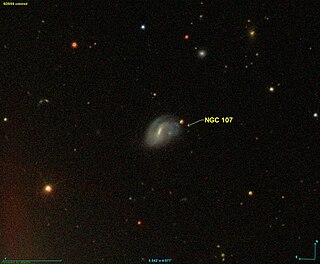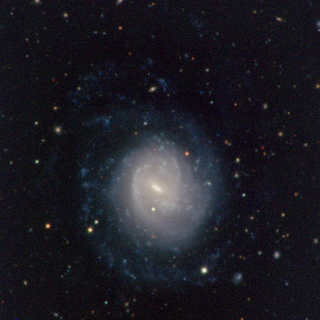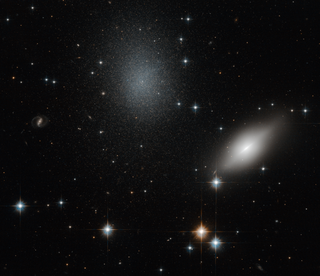
NGC 5545 is a spiral galaxy in the northern constellation of Boötes. It is interacting with the barred spiral galaxy NGC 5544.

NGC 5755 is a barred spiral galaxy in the constellation Boötes, member of Arp 297 interacting galaxies group of four: NGC 5752, NGC 5753, NGC 5754, and NGC 5755.

NGC 5775 is a spiral galaxy, a member of the Virgo Cluster, that lies at a distance of about 70 million light-years. Although the spiral is tilted away from us, with only a thin sliver in view, such a perspective can be advantageous for astronomers. For instance, astronomers have previously used the high inclination of this spiral to study the properties of the halo of hot gas that is visible when the galaxy is observed at X-ray wavelengths. It is a member of the NGC 5775 Group of galaxies, itself one of the Virgo III Groups strung out to the east of the Virgo Supercluster of galaxies.

NGC 98 is a barred spiral galaxy in the Phoenix constellation. The galaxy NGC 98 was discovered on September 6, 1834 by the British astronomer John Frederick William Herschel.

NGC 99 is a spiral galaxy in the constellation Pisces. It was discovered on 8 October 1883 by the French astronomer Édouard Stephan.

NGC 4634 is an edge-on barred spiral galaxy located about 70 million light-years away in the constellation of Coma Berenices. NGC 4634 was discovered by astronomer William Herschel on January 14, 1787. It is interacting with the spiral galaxy NGC 4633. Both galaxies are members of the Virgo Cluster.

NGC 3501 is a spiral galaxy 80 million light years away. It is located in the constellation Leo. The galaxy was imaged by the Hubble Space Telescope in 2014, showing an edge-on spiral galaxy; its companion NGC 3507 is not included in the photograph. It is a member of the NGC 3607 Group of galaxies, which is a member of the Leo II Groups, a series of galaxies and galaxy clusters strung out from the right edge of the Virgo Supercluster.

NGC 78 is a pair of galaxies in the constellation Pisces. NGC 78A, which is the more southern galaxy, is a barred spiral galaxy. NGC 78B, which is the more northern galaxy, is an elliptical galaxy. Although the designations NGC 78A and 78B are used today, the designation NGC 78 was formerly used mainly for the northern galaxy.

NGC 3718, also called Arp 214, is a galaxy located approximately 52 million light years from Earth in the constellation Ursa Major. It is either a lenticular or spiral galaxy.

NGC 90 is an interacting spiral galaxy estimated to be about 300 million light-years away in the constellation of Andromeda. It was discovered by R. J. Mitchell in 1854 and its apparent magnitude is 13.7. The galaxy is currently interacting with NGC 93 and exhibits two highly elongated and distorted spiral arms with bright blue star clusters indicative of star formation, likely caused by the interaction with its neighbor.

NGC 107 is a spiral galaxy estimated to be about 280 million light-years away in the constellation of Cetus. It was discovered by Otto Struve in 1866 and its magnitude is 14.2.

NGC 109 is a spiral galaxy estimated to be about 240 million light-years away in the constellation of Andromeda. It was discovered by Heinrich d'Arrest in 1861 and its magnitude is 13.7.

NGC 93 is an interacting spiral galaxy estimated to be about 260 million light-years away in the constellation of Andromeda. It was discovered by R. J. Mitchell in 1854. The galaxy is currently interacting with NGC 90 and has some signs of interacting with it.

NGC 3059 is a barred spiral galaxy. It is located in the constellation of Carina. The galaxy can be described as being faint, large, and irregularly round. It was discovered on February 22, 1835, by John Herschel. The galaxy has been calculated to be 45 - 50 million lightyears from Earth.

NGC 115 is a barred spiral galaxy located in the southern constellation of Sculptor. It was discovered by the British astronomer John Herschel on September 25, 1834. The galaxy is approximately 85 million light-years from the Sun, and is about 50,000 light-years in diameter, nearly half the size of our home galaxy, the Milky Way.

NGC 255 is a barred spiral galaxy in the constellation Cetus. It was discovered on November 27, 1785, by Frederick William Herschel.

NGC 5011 is an elliptical galaxy in the constellation of Centaurus. It was discovered on 3 June 1834 by John Herschel. It was described as "pretty bright, considerably small, round, among 4 stars" by John Louis Emil Dreyer, the compiler of the New General Catalogue.

NGC 1573 is an elliptical galaxy in the constellation of Camelopardalis. It was discovered on 1 August 1883 by Wilhelm Tempel. It was described as "very faint, small" by John Louis Emil Dreyer, the compiler of the New General Catalogue. It is located about 190 million light-years away.

NGC 485, also commonly referred to as PGC 4921 or GC 270, is a spiral galaxy in the constellation Pisces. It is located approximately 86 million light-years from Earth and was discovered on January 8, 1828 by astronomer William Herschel. It was later also observed by Heinrich d'Arrest and Herman Schultz. When NGC 485 was originally categorized in the New General Catalogue by John Louis Eil Dreyer in 1888, it was incorrectly described as a "considerably faint, pretty large, round, 8th magnitude star 3 1/2 arcmin to southwest".

NGC 950 is a barred spiral galaxy in the constellation Cetus. It is approximately 205 million light-years away from the Solar System and has a diameter of about 85,000 light-years. The object was discovered in 1886 by American astronomer and mathematician Ormond Stone.



















